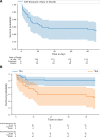Clinical features and outcome of influenza pneumonia in critically-ill immunocompromised patients
- PMID: 36626482
- PMCID: PMC9750560
- DOI: 10.1097/MD.0000000000032245
Clinical features and outcome of influenza pneumonia in critically-ill immunocompromised patients
Abstract
Immunocompromised subjects are at risk of severe viral infections which may require intensive care unit (ICU) admission. Data on the outcome of influenza pneumonia in critically-ill immunocompromised subjects are limited. We conducted a single-center observational study. All subjects admitted to the ICU for influenza pneumonia between 2016 and 2020 were included. The main objective was to compare the clinical features and outcome of critically-ill subjects with flu according to their immune status. 137 subjects (age 60 years-old, 58.4% male) were included, of whom 58 (42.34%) were intubated during the ICU stay. Forty-three (31.4%) subjects were immunocompromised. Immunocompromised subjects had a higher Charlson comorbidity index. In contrast, severity scores and hypoxemia at ICU admission, and ventilatory support during ICU stay were similar between the 2 groups. There was no difference in the rate of co-infections and ventilator-associated pneumonia between the 2 groups. Among intubated subjects, 10 (23.26%) immunocompromised subjects developed severe acute respiratory distress syndrome compared to 13 (13.83%) non-immunocompromised (P = .218). ICU mortality was 13.97%, with mortality being 3-times higher in immunocompromised subjects (25.58% vs 8.6%, P = .015). On multivariable analysis, immunocompromised status, higher age and lower arterial oxygen partial pressure/fraction of inspired oxygen were associated with an increased ICU mortality. Immunocompromised subjects with severe influenza pneumonia were more likely to develop severe acute respiratory distress syndrome and had a 3-fold increase in ICU mortality compared to non-immunocompromised subjects. Such difference was not explained by an increased rate of co-infections or nosocomial pneumonia, suggesting that influenza virus was by itself responsible of a more severe form of pulmonary disease in immunocompromised subjects.
Copyright © 2022 the Author(s). Published by Wolters Kluwer Health, Inc.
Conflict of interest statement
EC has received lecturer and conference-speaker fees, as well as reimbursements of travel and accommodation expenses related to attending scientific meetings, from Gilead, Baxter, and Sanofi-Genzyme. None of the other authors has any competing interests to disclose.
Figures
References
-
- Influenza (Seasonal). Available at: https://www.who.int/news-room/fact-sheets/detail/influenza-(seasonal). [Accessed April 2, 2022].
-
- CDC. What you need to know about influenza (flu) from CDC. Centers for Disease Control and Prevention. Available at: https://www.cdc.gov/flu/weekly/fluactivitysurv.htm. [Accessed April 2, 2022].
-
- SPF. Surveillance de la grippe en France, saison 2018-2019. Available at: https://www.santepubliquefrance.fr/import/surveillance-de-la-grippe-en-f.... [Accessed November 21, 2021].
-
- Uyeki TM, Bernstein HH, Bradley JS, et al. . Clinical practice guidelines by the infectious Diseases society of America: 2018 update on diagnosis, treatment, chemoprophylaxis, and institutional outbreak management of seasonal influenzaa. Clin Infect Dis Off Publ Infect Dis Soc Am. 2019;68:e1–e47. - PMC - PubMed
Publication types
MeSH terms
Substances
LinkOut - more resources
Full Text Sources
Medical


